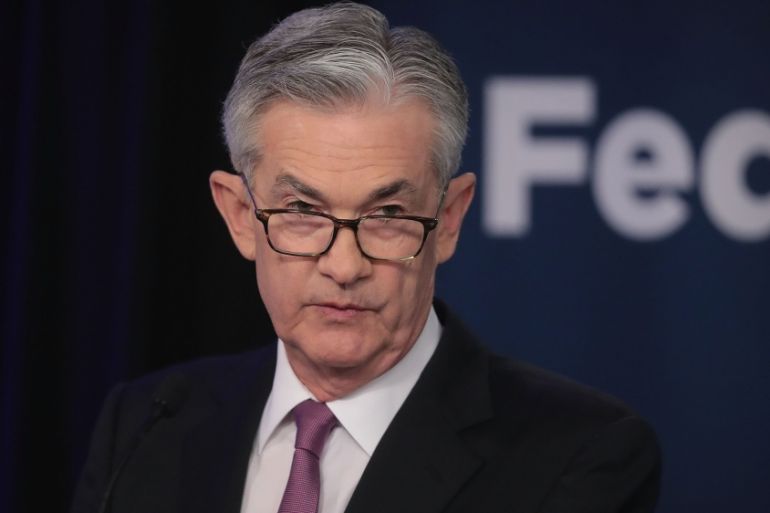US Fed holds interest rates steady, but signals cuts could come
US central bank drops ‘patient’ approach, implying that uncertainty may lead to lower borrowing costs in 2019.

The United States Federal Reserve left interest rates unchanged at the conclusion of its two-day policy meeting in Washington on Wednesday, but signaled it could cut interest rates – doing so for the first time in a decade – at some point later this year.
The closely scrutinised post-meeting statement by the US central bank dropped a reference to being “patient” with its policy course, and added that “uncertainties” about the outlook for the US economy “have increased”.
Keep reading
list of 4 itemsWhy are nations racing to buy weapons?
Parallel economy: How Russia is defying the West’s boycott
US House approves aid package worth billions for Ukraine, Israel
In light of those growing uncertainties and a lack of price pressure, the Fed said it will continue to monitor data and “act as appropriate to sustain” nearly 10 years of US economic expansion.
St. Louis Fed President James Bullard, who had argued that rates should be cut, dissented in Wednesday’s policy decision to hold rates steady.
Though almost half of Fed policymakers now show a willingness to lower borrowing costs over the next six months, the central bank will wait to act.
“The prospects for job seekers have never been better,” Federal Reserve Chairman Jerome Powell told reporters during his post-meeting press conference. “And wages have been rising.”
While new economic projections showed that policymakers’ views of growth and unemployment are largely unchanged, they see headline inflation at just 1.5 percent for the year, down from the 1.8 percent projected in March.
They also expect to miss their two percent inflation target next year as well.
Seven of 17 policymakers said they expected it would be appropriate to cut rates by half of a percentage point by the end of 2019, and an eighth saw a rate cut of a quarter point as appropriate.
That was not enough to change the median outlook for the Fed’s targeted overnight lending rate, which officials projected to remain in a range between 2.25 percent and 2.50 percent for the rest of this year.
But it still represented a significant shifting of views on the Fed. It appears many, and perhaps most, policymakers trimmed a full half percentage point from their outlook for rates. Only one policymaker continues to see a rate hike as likely in 2019.
‘Sustained expansion’
The long-run federal funds rate, a barometer for the state of the US economy over the long term, was indeed cut to 2.5 percent from 2.8 percent.
US stocks rose higher after the Fed’s statement was released, with the benchmark Standard & Poor’s 500 index up about 0.25 percent from the previous day’s close. Ahead of the statement, stocks had been fractionally lower on the day.
Yields on US Treasury securities, which had been modestly higher before the rate decision was released, slipped. The 10-year Treasury note yield was down one basis point, at just shy of 2.05 percent. Meanwhile, the dollar weakened against the euro.
Along with the change in the policy statement, Wednesday’s projections open the door for the central bank to lower rates in short order if the economy weakens or if US trade disputes with China and other nations escalate.
The Fed continues to label the labour market as “strong” and also said “sustained expansion of economic activity” and eventually rising inflation were still “the most likely outcomes”. The drop in inflation, however, was a blow for a central bank hoping to reach its target sometime next year.
The policy meeting was the first since President Donald Trump hiked tariffs on $200bn of Chinese imports and threatened – though ultimately decided against – imposing new tariffs on Mexican goods.
Those actions caused Fed officials to change their tone from largely dismissing the macroeconomic fallout of Trump’s trade policies to worrying that persistent new tariffs and shifting global supply chains could be emerging.
Meanwhile, Fed chairman Powell on Wednesday responded to a reporter’s question about whether he could be demoted by the president for not cutting rates fast enough – which could constitute interference by the executive branch and a threat to the central bank’s authority.
“I think the law is clear,” said Powell. “I have a four-year term, and I fully intend to serve it.”
The Fed should not be under the president’s influence in setting monetary policy, US Congress House of Representatives Speaker Nancy Pelosi said on Wednesday.
“The last thing we need is a president threatening the chairman of the Fed on whether he is raising or lowering rates in tune with the president’s politics,” Pelosi said. “You have to have an independent Federal Reserve.”